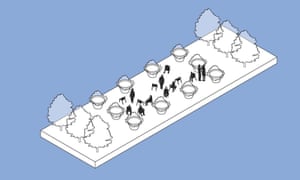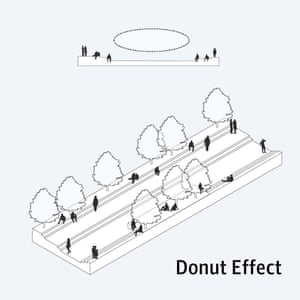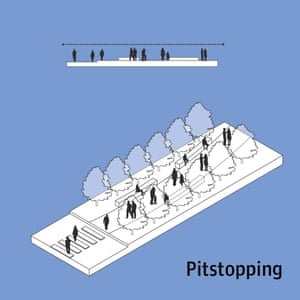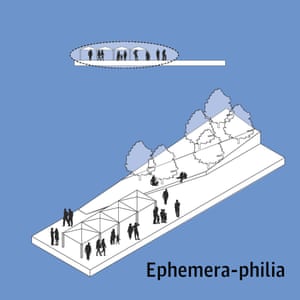
How humans really behave in public spaces
The researchers behind The Field Guide to Urban Plazasdecided to study the public behaviour of human beings in New York City, an update on William H Whyte’s pioneering work from 1980, The Social Life of Small Urban Spaces. From ‘roosting’ to ‘schooling’, here are the patterns they found
-
The research found people tended to occupy the edges of a plaza before filling in the middle. This was observed in a range of plazas, including those with seating and planting distributed evenly throughout the space. Generally, the capacity along the edge reached 50%-75% before people began migrating into the middle

-
Views of the city attracted people, even if comfort was compromised or the site not easily accessible. People were drawn to views in both highly trafficked tourist areas and areas with less traffic. In both types of spaces, people tended to go straight towards the best view first. Many lingered long enough to take a photo. If seating was available nearby, this often extended their time spent in the space by 10 to 15 minutes. Some people even perched on the backs of benches to get a better view

-
Pathways with minimal edge variation sped up pedestrian traffic and lowered dwell times in the plazas. People tended to walk faster and stop less frequently in straight pathways through plazas. These pathways were often undifferentiated from their surroundings in terms of hardscape and planting material and had few or no openings to the plaza
Photograph: SWA

-
People didn’t dissipate evenly throughout the spaces. Schooling was observed in most of the plazas. People were not deterred by crowding or groups of people; rather, people seemed to be attracted to spaces with a medium-to-high density of people over spaces with a lower density
Photograph: SWA

-
Slightly perched and protected areas were popular. Stationary people tended to go to elevated areas that overlooked the plaza space. The youngest gravitated towards higher perches (at least 3ft), and the middle aged were drawn to slightly raised spaces (under 3ft). Protected perches with canopies and a sense of backing were most popular

-
Soft material in the sun attracted people to recline. Young plaza users tended to bask in the sun if offered a soft surface such as wood or turf. This was observed in a range of spaces of varying elevation. Most often, people basked in small groups of two-to-four

-
People seeking privacy chose spurs with good visibility. This was observed in plazas with a varied series of outdoor rooms. Individuals eating alone, on a phone call or reading often found seating outside the main plaza space and off the main circulation routes. Favoured locations tended to have strong backing (with walls, furniture, or planting) and clear views out into the plaza

-
Younger groups tended to occupy bi-directional areas where they could be part-audience, part-performer. Teenagers occupying the plazas wanted to see what was going on around them and be seen. During their time in the space, they toggled back and forth between these roles. Adjacent circulation increased the popularity of these spaces

-
People tended to occupy protected, in-between spaces. When given the option, many plaza users gravitated towards liminal plaza zones – seating areas that felt sheltered but were directly adjacent to a more open and exposed area. These types of spaces were very crowded and had long dwell times, often more than 30 minutes per group
Photograph: SWA

-
Spaces with a sense of backing, where there was less activity behind them, attracted people. This phenomenon was observed in most of the plazas with people wanting protective seating. The backing took many forms – from higher plant material to walls, to construction fences and jersey barriers. People tended to occupy these seating areas over more exposed spaces

-
People often moved to face the sun. Many young people were observed doing this in the plazas and would seek sunny areas to linger in. In tracking the rays, they often shifted their positions on stationary furniture or even moved to other areas of the plaza in order to stay in the sun
Photograph: SWA

-
A low element at the edge of an outdoor room attracted people. One well-used subdivision of plazas was an area surrounded by a low element, generally under 4ft. This took the form of planters, jersey barriers, a glass rail, or a mesh rail. Clear sightlines into and out of the space seemed to be important for those using the corral. These subdivisions created refuge islands, allowing people to get away from busy areas but still have views to pedestrians

-
Fixed areas that offered a choice in seating type, height, material, or personal position had high dwell times. In general, people preferred variety in seating – they tended to occupy spaces that had a range of furniture to choose from. For example, if seating was designed with multiple heights and depths, people used it for sitting on, standing by, lying on,and leaning on

-
Plazas that incorporated crosswalks or sidewalks resulted in pedestrians slowing down or stopping on their way. Extending adjacent pathways through a plaza resulted in increased dwell time and increased overall use of the space. People who used pathway extensions that cut through the central part of the plaza space often lingered more when compared with people who used pathways on the plaza edge
Photograph: SWA

-
Temporary plaza interventions drew people into the space. Interventions that had a limited lifespan, from one day to an entire season, tended to increase usage of the plaza. These interventions seemed to work better in spaces populated by locals rather than in spaces sought out by visitors
Photograph: SWA

-
Plazas with wide and open entrances at cross streets or transverse paths facilitated higher flows of people. More people tended to pass into plazas from adjacent public spaces if the edge of the plaza was unobstructed by planting, furniture or walls. The wider the entrance, the greater the flow

-
People used accessible elements at the edges of plazas to take short breaks. This was observed in many plazas with high flows of pedestrian traffic. Those walking on the edge of plazas took short breaks and lingered if there were elements such as walls or planters to lean on or set their belongings upon. People often did this while waiting – for a bus, for the light to change, or to meet up with a friend
Photograph: SWA

-
People sat facing the street but were not often watching traffic. Streets seemed to provide ambient background noise for plaza users. People voluntarily sat close to the flow of traffic even if other seating options were available. Many of these people were sitting by themselves, often reading or on their phones

-
People liked to move along building edges. Pathways sandwiched between plazas and adjacent buildings were well-used, especially as cut-throughs. These corridors were successful even if they were very narrow (5ft-7ft wide) and even if the building edges were not well activated

-
People sat facing an area with a constant flow of pedestrian traffic, even if there were other options. Stationary people tended to want to watch others, especially in active areas with high pedestrian turn-over. These plaza users even sat facing a blank wall as long as between the seating and the wall there was significant movement. Two well-used streams, especially if perpendicular to one another, created additional visual interest for those watching

-
Reflective surfaces were major plaza attractors. Mirrored sculptures were destinations for those visiting plazas. People approached a piece and lingered around it for a few minutes, often taking photos of their reflection with the cityscape behind. Size and location of the piece didn’t seem to matter

-
Groups of people tended to congregate around objects, even if they were not using them. This phenomenon was observed in most plazas. When three or more people stood or sat together in a group, they often did so around a piece of furniture, low planter, flat-topped bollard, or even a garbage can. The groups represented a range of plaza users, from office workers to tourists

-
Large groups of people gravitated towards moveable furniture. In situations where four or more people wanted to sit together, they often bypassed fixed seating, preferring to use moveable or partially moveable seating instead. This type of furniture included fixed seats with moveable pieces that swivelled and transformed. After settling on an area of the plaza to use, the groups typically rearranged the furniture to best fit their needs
Photograph: SWA

-
People made furniture out of anything. In most plazas, especially those that were saturated, people got creative when it came to seating and tables. Plaza users sat on many objects not intended for furniture such as peaked curbs, security bollards with flat tops, jersey barriers, and electrical boxes. They also used many types of objects to eat meals off

-
People looked to prop their feet up. Plaza users sitting by themselves often found a way to recline and put their feet up. With fixed benches, this typically meant that they took up more space by rotating their body parallel to the bench. With moveable chairs, people dragged chairs close to a fixed element, such as a low planter wall, that could be used as a foot prop. With moveable chairs, people often occupied two chairs – one to sit in and one for the feet

